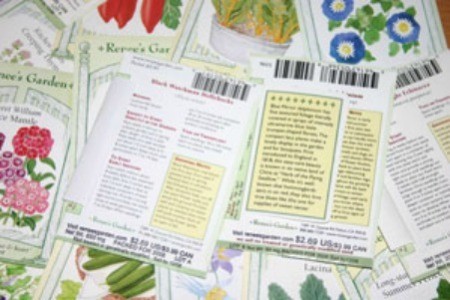Starting plants from seed is an economical and rewarding way to garden. However, if you don't understand the meanings behind garden-specific terms like "hardy" and "tender" or "resistant" and "tolerant", you could end up with some disappointing results down the road. There is a set of standardized terms on seed packets, but here are some definitions to the terms you are most likely see.
| Term | Definition |
| Annual: | A plant that germinates, flowers, and dies (completes its life cycle) in one season. Some annuals may reseed themselves. |
| Biennial: | A biennial plant takes two years to complete its life cycle. The plant grows leaves, stems and roots the first year and then enters a period of dormancy (usually over cold months). It flowers the second year. Some bienneials may reseed themselves. |
| Bush: | Refers to a plant (usually beans) that has a more bushy shape and a growing habit more compact and low to the ground. |
| Climbing or pole: | Referring to plants that have an upright or sprawling growing habit and require sturdy supports. |
| Compact: | An indicator of a growing habit and shape. Compact plants are often well suited for container gardens. |
| Cool-season: | Refers to seed that will germinate and grow in cool weather in the spring or fall. Seedlings will usually withstand a light frost, but are more likely to fail during summer heat. |
| Date: | Indicates the year the seed producer intended the seed to be grown. |
| Dwarf: | Grows shorter than the normal size for plants in its family. |
| Days (to maturity or harvest): | Usually refers to number of days from sowing to harvest, but can also refer to days from outdoor transplanting of seedlings to harvest. |
| Direct-sow/direct seeding: | Refers to sowing seeds directly outdoors in the place you intend to grow them. |
| F1 hybrid: | Seeds that are a first generation cross between two purebred plants. Mature plants grown from these seeds will produce seed that does not have the same characteristics as its parents, making it necessary to purchase new seed each year. |
| Germination: | The initial growth period of the seed. |
| Hardiness zone: | Sometimes shown as a number or range of numbers inside of an icon, the hardiness zone refers to the USDA Hardiness Zones, and map made up of 11 zones based on the average minimum temperature in the winter. For example, if a plant is recommended for zone 5 it will grow (should withstand the average minimum temperatures) in zones 5 and higher. |
| Hardy: | When a plant has the ability to withstand low temperatures and at least a light frost. |
| Heavy feeder: | Needs frequent fertilizing. |
| Heirloom: | Old-time varieties of seeds (usually 50 years or more). |
| Invasive (or vigorous) growth: | Code for may take over your entire garden if you're not careful. |
| Naturalized: | Refers to a plant that grows well in a region to which it is not native. |
| Open-pollinated: | Mature plants grown from open-pollinated seed will produce seed with the same characteristics as its parents and allow you to collect seeds for the next year. |
| Organic: | Seed obtained from plants that have been grown without the use of herbicides and insecticides according to federal organic standards. |
| Pelletized: | Seeds (usually small seeds) that have been coated with an inert material just to make the handling of the seed easier. |
| Perennial: | A perennial plant lives for three or more seasons. It usually grows and blooms over the spring and summer, dies back in the winter and returns the following spring from its own rootstock. |
| Resistant: | This term is often used interchangeably with the term tolerant, but technically speaking they are different. Resistant refers to a plant that is not likely to be affected by a specific stressor such as diseases, insects, pests, or drought. |
| Scarify: | Scratch outer shell to encourage germination. |
| Self-Sow: | When a plant drops seeds that will produce seedlings without any assistance. |
| Start indoors: | Refers to starting seeds indoors in the late winter or early spring. |
| Tender: | A plant that is easily killed by a light frost. |
| Tolerant: | This term refers to plants that, once established, will tolerate at least a modest amount of a particular stressor, such as drought, pests, disease, or cold. |
| Treated: | Indicates seeds have been treated with chemicals in an effort to control disease(s). |

About The Author: Ellen Brown is an environmental writer and photographer and the owner of Sustainable Media, an environmental media company that specializes in helping businesses and organizations promote eco-friendly products and services. Contact her on the web at http://www.sustainable-media.com
Add your voice! Click below to comment. ThriftyFun is powered by your wisdom!
What is hoarfrost? I saw this on a seed packet one day.
Editor's Note: Frozen water vapor formed in clear still weather on vegetation, fences, etc.
Add your voice! Click below to comment. ThriftyFun is powered by your wisdom!